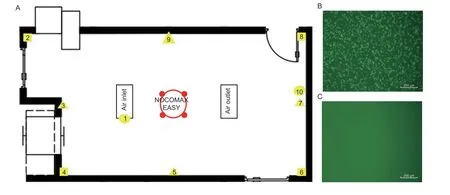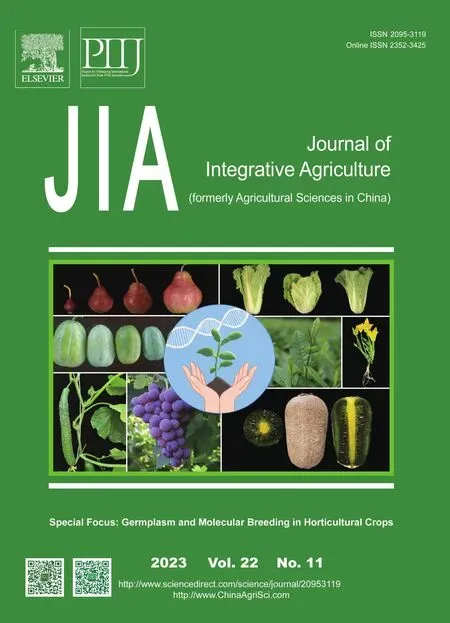Virucidal activity of MICRO-CHEM PLUS against African swine fever virus
JIANG Cheng-gang, SUN Ying, ZHANG Fan, AI Xin, LU Ming, QIN Jia-lin, ZHANG Xian-feng,WANG Jing-fei, BU Zhi-gao, ZHAO Dong-ming#, HE Xi-jun#
1 State Key Laboratory for Animal Disease Control and Prevention, Harbin Veterinary Research Institute, Chinese Academy of Agricultural Sciences, Harbin 150069, P.R.China
2 National High Containment Laboratory for Animal Diseases Control and Prevention, Harbin 150069, P.R.China
African swine fever (ASF) was first discovered and reported in East Africa in 1921 and it has been listed as a notifiable animal disease by the World Organization for Animal Health (WOAH) due to the high morbidity and mortality (WOAH 2019).African swine fever virus (ASFV)can persist in pig farm environments, carcasses, and various pig products (Petriniet al.2019).ASF has caused significant economic losses to the pig industry since its outbreak in China in 2018 (Zhaoet al.2019).This accelerated the basic research and vaccine development pertaining to ASF in China.The Ministry of Agriculture and Rural Affairs of the People’s Republic of China issued a notice on strengthening the biosecurity supervision of ASFV-related experimental activities; laboratories engaged in ASFV-related experimental activities were required to have the corresponding biosecurity protection levels.In biosafety Level 3 (BSL-3) laboratories,it is important to disinfect for suspected infectious agents effectively.In biosafety cabinet, experimental consumables should be thoroughly disinfected by soaking, spraying, or wiping them with disinfectant before autoclaving.Therefore, it is necessary to choose effective disinfectants for preventing ASFV contamination.
High-efficiency disinfectants such as chlorinecontaining disinfectants, formaldehyde, glutaraldehyde,hydrogen peroxide, and peracetic acid are often preferred in high-containment laboratories.However,these disinfectants are toxic to human.In addition, they can easily cause corrosion to the facilities and metal equipment in high-containment laboratories, particularly to precision instruments.Therefore, it is important to screen for safe and efficient disinfectants against ASFV that could be suitable for high-containment laboratories.MICROCHEM PLUS (MCP) is widely used as a disinfectant in BSL-4 laboratories in the United States, Canada, and Australia (Lackemeyeret al.2014).MCP is a mixture of quaternary ammonium compounds (QACs).QACs were low toxicity, and weakly corrosive disinfectant (Linet al.2018).Their low toxicity and ability to be formulated for specific applications and target organisms account for their widespread use.The official website of the manufacturer claims that it has bactericidal, fungicidal,and virucidal activities against adenovirus, influenza virus,coronavirus, human immunodeficiency virus type 1 (HIV-1),and hepatitis C virus.MCP has a good inactivation effect on Severe acute respiratory syndrome-associated coronavirus (SARS-CoV-2) (Huanget al.2022b) and Nipah virus (Huanget al.2022a).The inactivation effects of commercial disinfectants against ASFV were previously assessed (Jianget al.2021).However, effect of MCP on ASFV has not been reported.In this study,the inactivation of ASFV by MCP was evaluatedinvitro.The findings will provide the necessary validation for the rational use of disinfectants in ASFV research in highcontainment laboratories.
We evaluated the effects of the multicomponent quaternary ammonium compound QAC, MCP, on the inactivation of ASFV.The main component of MCP is a double-chain quaternary ammonium salt, which is a medium-efficiency disinfectant that significantly reduces the corrosion of instruments and equipment.A fluorescence-basedinvitroassay was used to determine the virucidal activity of MCP.The replication of HLJ/18-DP148R-del could be tracked by the expression of eGPF.Importantly, the deletion of DP148R did not affect the virulence of HLJ/18 in pigs (Chenet al.2020).So HLJ/18-DP148R-del may be equivalent to its parental HLJ/18 isolated from the infected pigs (Zhaoet al.2019).The replication of HLJ/18-DP148R-del can be reflected by the expression of eGPF because the genome of HLJ/18-DP148R-del contains eGFP expression box which is driven by viral p72 promoter of ASFV, which is convenient to detect ASFV infection or not.
The results showed that 5% MCP was highly toxic to PAM cells; however, after MicroSpin filtration, the toxicity of the disinfectant to PAM cells was effectively neutralised,but compared to that in the positive control group, no significant difference in the titer of the virus was observed after MicroSpin filtration.
The results of the immersion disinfection assay(fluorescence-based) are provided in Table 1.At 4°C,25°C, or 37°C, MCP completely inactivated ASFV (virus HAD50mL–1titer: concentration, exposure time) as following, 106: 5%, 1 min; 3.3%, 5 min; 1.6%, 15 min and 0.8%, 30 min; 105: 5%, 1 min; 3.3%, 1 min; 1.6%,5 min and 0.8%, 15 min; 104: 5%, 1 min; 3.3%, 1 min;1.6%, 1 min and 0.8%, 5 min; 104: 5%, 1 min; 3.3%,1 min; 1.6%, 1 min and 0.8%, 1 min.Results of the spray disinfection assay (fluorescence-based) are provided in Table 1.At 4°C, 25°C, or 37°C, MCP completely inactivated ASFV (virus HAD50mL–1titer: concentration,exposure time) as following, 106: 5%, 5 min; 3.3%, 15 min and 1.6%, 30 min; 105: 5%, 1 min; 3.3%, 5 min; 1.6%,15 min and 0.8%, 30 min; 104: 5%, 1 min; 3.3%, 1 min;1.6%, 5 min and 0.8%, 15 min; 104: 5%, 1 min; 3.3%,1 min; 1.6%, 1 min and 0.8%, 1 min.The NOCOMAX EASY diffuser machine was used to spray 5% MCP at 25°C in a laboratory (length 7.7 m, width 4.5 m, and height 3 m) which biological indicators were placed in different positions (Fig.1).At a spray time of 15 min(0.015 L m–3), terminal disinfection could not be achieved,as indicated by ASFV,Bacillusatrophaeus,Escherichia coliandStaphylococcusaureus.After spraying for 30 min(0.03 L m–3), terminal disinfection ofE.coliandS.aureuswas achieved.After spraying for 60 min (0.06 L m–3),inactivation of ASFV,E.coliandS.aureuswas achieved,butB.atrophaeusremained viable.

Table 1 Inactivation of African swine fever virus (ASFV) by MICRO-CHEM PLUS (MCP) at different conditions1)

Fig.1 A, the position of the petri dishes in the laboratory (length 7.7 m, width 4.5 m, and height 3 m).Dishes #1 and #10 were placed highest in the room (about 2.8 m from the ground), #2, #4, #6, and #8 were placed on the floor of the room, and #3, #5,#7, and #9 were placed in the middle of the room (about 1.5 m from the ground).B, green fluorescence observed in the positive control group.C, absence of green fluorescence in the negative control group.
Results show that the inactivation effect of the disinfectant reduced with a higher viral titer, which suggests that cleaning before disinfection is crucial.It has proved that thorough cleaning can often remove 90% of pathogenic microorganisms on surface (Juszkiewiczet al.2019).In addition to this, the application environment is not thoroughly cleaned, organic substances such as manure, bedding, straw, and feedstuffs could interfere with the activity of the disinfectant.This study provides preliminary data on the effectiveness of the disinfectant,MCP in inactivating ASFV, however, additional experiments are necessary to verify the inactivation effect of disinfectants on ASFV in the presence of organic substances.
In summary, MCP can inactivate ASFV in the absence of organic materials and can be used as an alternative to other toxic, corrosive commercial disinfectants,especially in the context of ASFV, which is studied in high-containment laboratories and is especially abundant on animal farms.A NOCOMAX EASY diffuser machine with 5% MCP can be used for terminal disinfection in the laboratory room contaminated by ASFV,but it is not effective against spore-forming bacteria.
Declaration of competing interest
The authors declare that they have no conflict of interest.
Ethical approval
All applicable internaltional, national and institutional guidelines for the care and use of animals were followed.
Acknowledgements
This study was supported by the National Key Research and Development Program of China (2021YFC2600305 and 2021YFD1801405).
 Journal of Integrative Agriculture2023年11期
Journal of Integrative Agriculture2023年11期
- Journal of Integrative Agriculture的其它文章
- Germplasm and molecular breeding in horticultural crops
- Development and application of KASP marker for high throughput detection of the seedless trait in grapevine
- QTL analysis of early flowering of female flowers in zucchini(Cucurbita pepo L.)
- A novel mutation in ACS11 leads to androecy in cucumber
- Comprehensive analysis of the full-length transcripts and alternative splicing involved in clubroot resistance in Chinese cabbage
- Effects of the combined application of organic and chemical nitrogen fertilizer on soil aggregate carbon and nitrogen: A 30-year study
